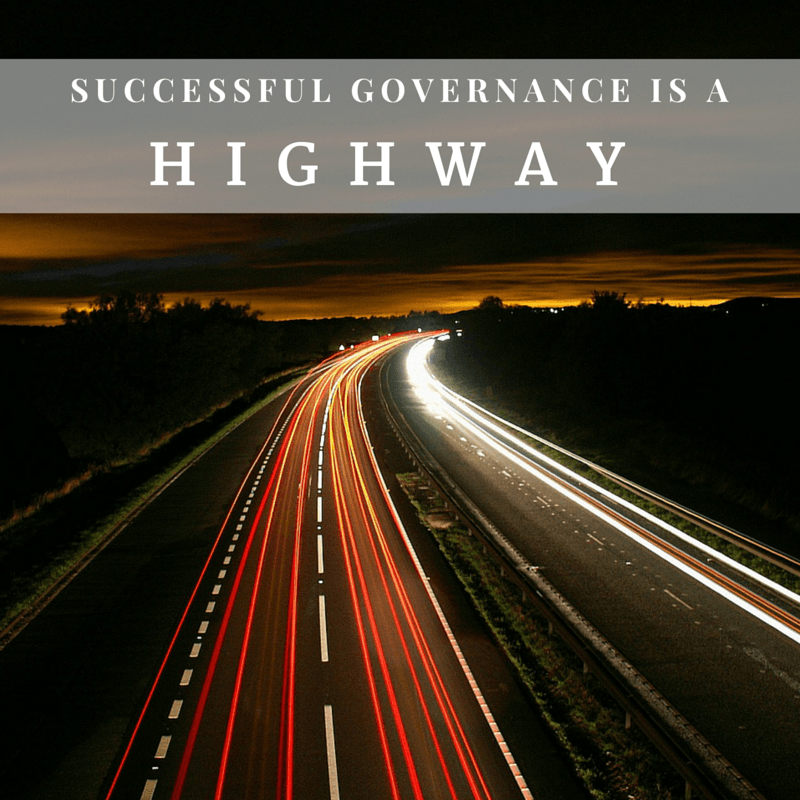
Over the years, I have spent a lot of time focused on developing new processes and governance for organizations. No matter what the expected outcomes, I have found the same general approach and key elements to rule the day.
When I’m asked to explain my approach to much in work or life, I tend to use analogies. Few of my family and friends (with some rare exceptions) understand what I do for a living. Relating the conceptual to tangible things they are familiar with is easier for both of us.
I have found, like life, successful governance is a highway.
Destination
Imagine you’re in a car and you want to be somewhere other than where you are. Where do you start?
You have to have an idea of where you want to go in order to get there. Just saying “I don’t want to be here” is not enough. An awareness of the destination you have in mind will get you started…either North, South, East or West.
More refinement requires specifics, but to get going, it’s enough to have a general idea in mind.
In governance, this is a Vision. A sense of the end state we want to achieve. It doesn’t have to be specific, but for everyone to head towards some common understanding and process, there needs to be an idea of what success looks like.
This will be our “true north” and keep all the work we do in general alignment, even if we make adjustments over time.
Jersey Barriers
Now that you’ve picked a general destination and started moving forward, you have to navigate within some number of lanes. You can go fast or slow, get behind someone walking their car, or even occasionally break the rules a little by passing on the right.
What you can’t do is break through the jersey barriers on the outer edges of the road, at least not without significant damage and cost. They keep all drivers within a confined space, heading in the same direction with a defined amount of flexibility in how they navigate within that space.
These “bumpers” are the outer limits we can afford to accept in governance. What do we have to ensure and “lock” for the process to work?
You want to give enough flexibility to allow teams to execute on their commitments and feel like they are able to run their business. However, acceptable limits should be understood and it should be painful and costly not to stay within them.
The Fast Lane
Everyone is now going in the same direction, within specified limits, with room to maneuver at their own speed, whether they choose the flash Ferrari or economy of a Toyota to run their team.
It’s time to start introducing the processes and parameters needed to refine the governance model to its eventual maturity level.
If you are familiar with EZ-Pass, it allows a driver to pay a toll without having to stop and pay an attendant. In our part of the country, we recently upgraded one of our tolls so that two lanes on the left can go through the tolls at full speed. Others continue to navigate through the toll gates based on their choices.
In governance, it’s critical to identify the types of conditions and decisions that allow teams to blow through the process without slowing down. As long as the teams are operating within those conditions, they can make commitments and deliver on them with no burdensome process to weigh them down.
If every part of the process is a challenge, it won’t be followed. Make it easy to get through for a good number of teams/efforts, so that when it matters you can institute…
The Toll Gate
Those teams that need to do or try something different, or have a need that has been identified as “toll-worthy,” must take an alternate path.
On the road, it takes a moment to stop and pay the toll. It’s not intended to prevent you from moving forward, but it does make you hesitate.
In governance, we need to be able to introduce an operational pause for certain types of efforts, decisions, etc. We don’t want to delay work, but we need the opportunity to evaluate the effort against pre-defined considerations.
What if two teams want to do similar work? We may have the opportunity to align their efforts and save money. What if we expected to spend x on an effort and now we’re spending twice as much? We may want to evaluate whether the effort is still worth pursuing.
Such decisions can only be made if we introduce a pause in the process.
Rules of the Road
The highway is generally a smooth running operation. Drivers understand the rules and expected behaviors. Some follow those rules and behaviors, others bend or break them, causing accidents and traffic jams.
Whether they like them or not, drivers understands the purpose and value of the rules. Ultimately, if everyone was allowed to do whatever they want, whenever they want, there would be chaos and no one would get anywhere.
The same is true of governance. It is only through understanding the value of each component above, the role everyone plays, the expected timing and need to keep things quick and light (so we don’t have traffic jams), that we can get full participation and a workable model.
Otherwise, it’s complete chaos.
Have you introduced governance in a team or organization? What other components do you find to be valuable? I’d appreciate if you could add your comments below and keep the conversation going.








